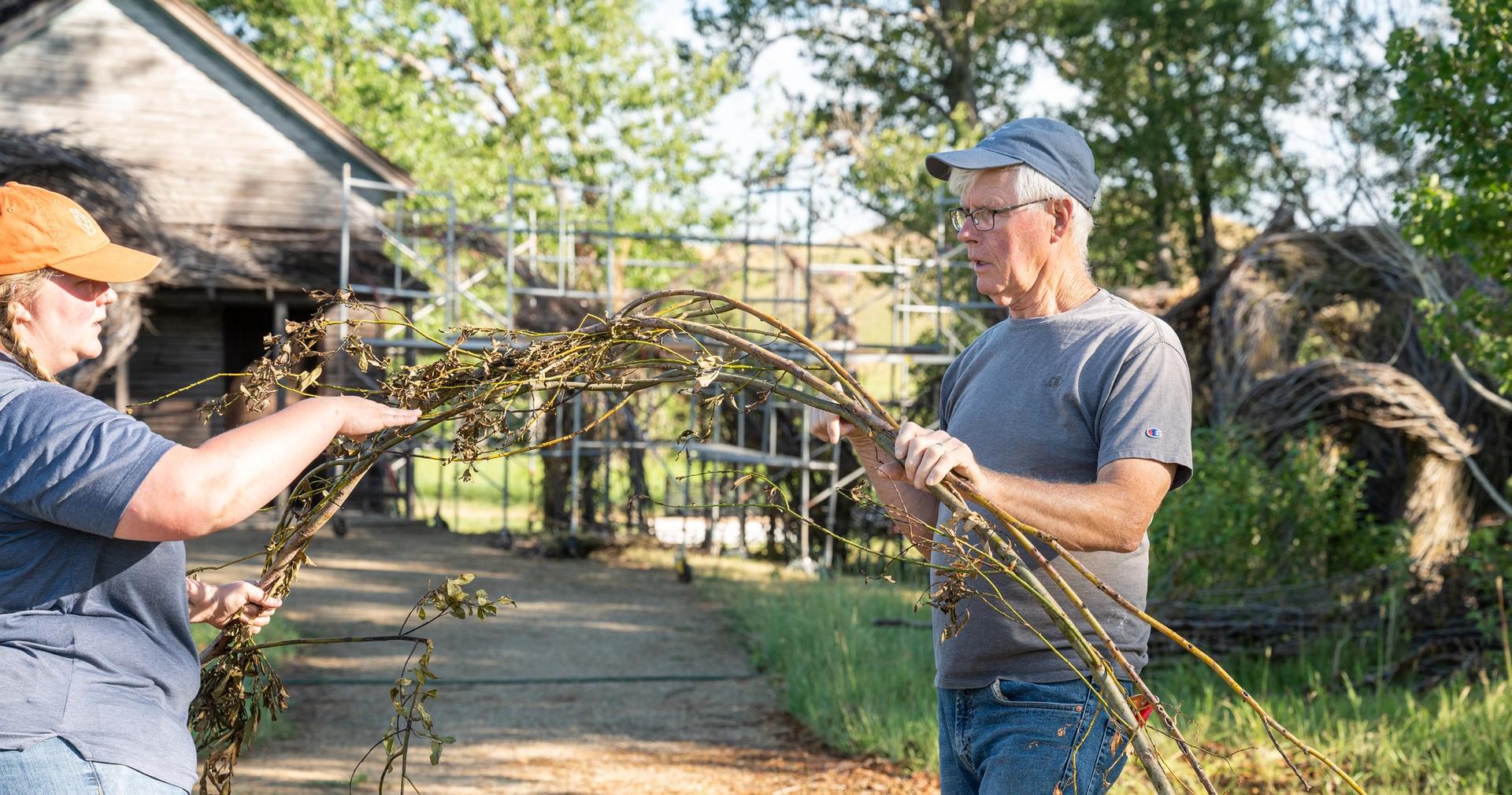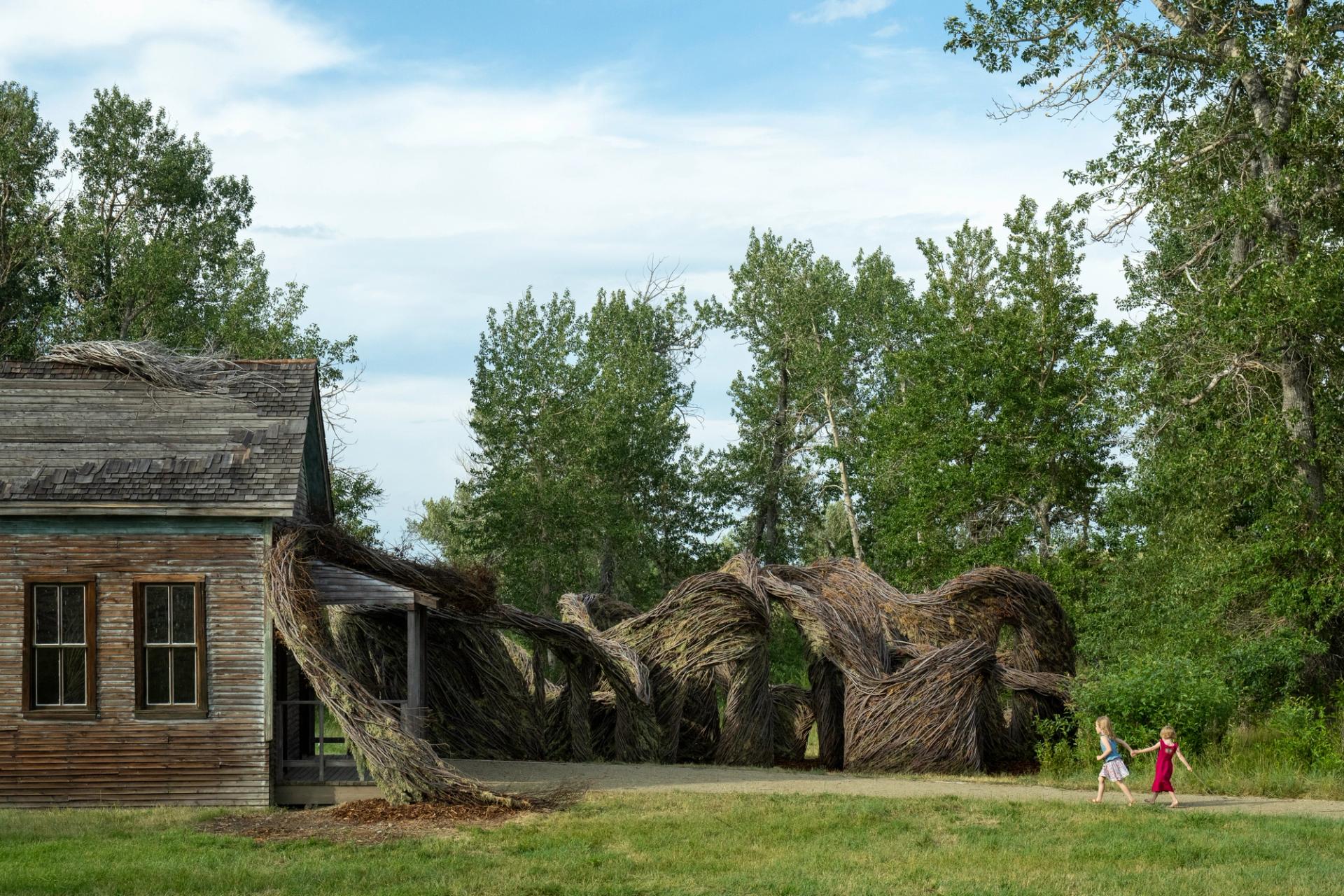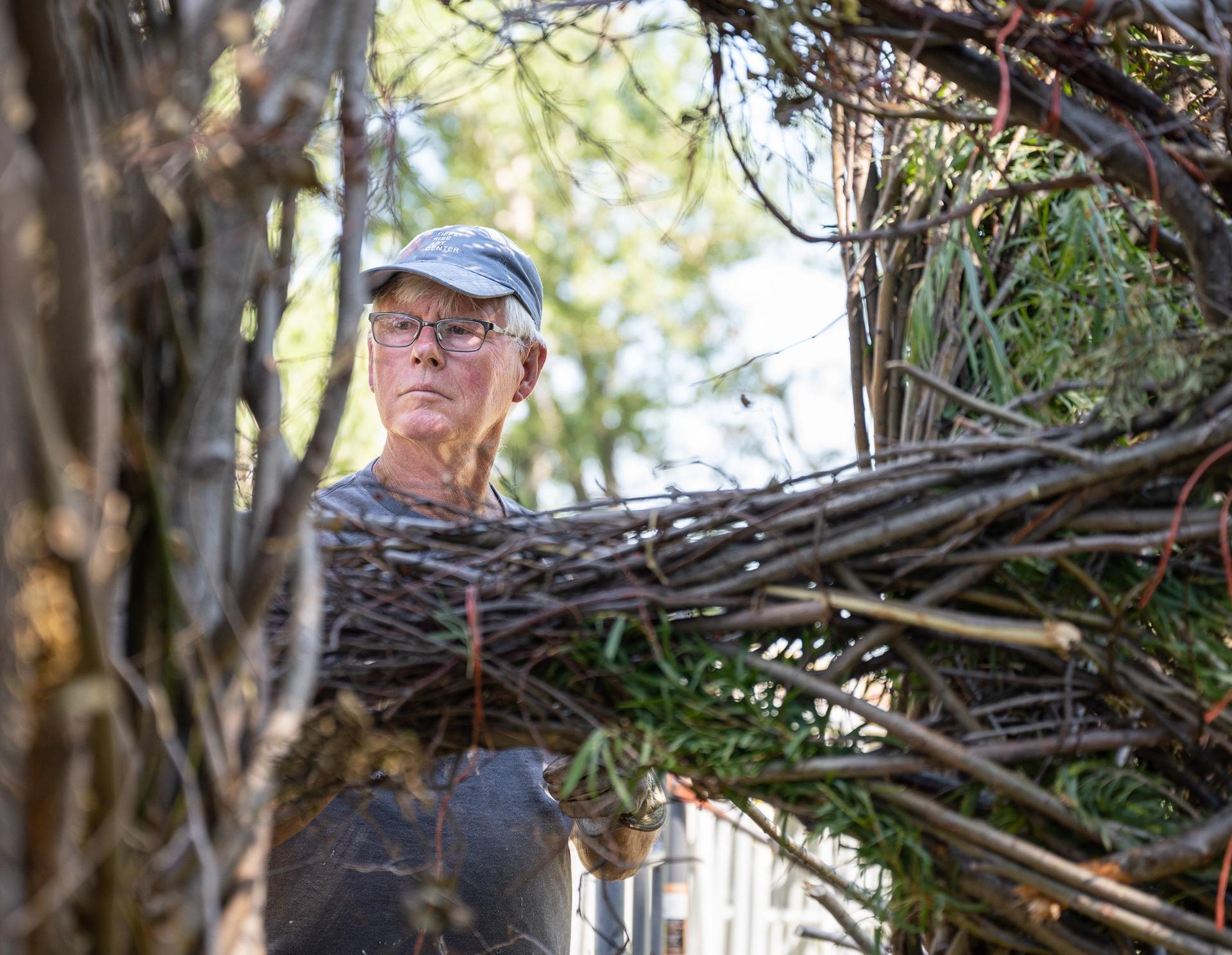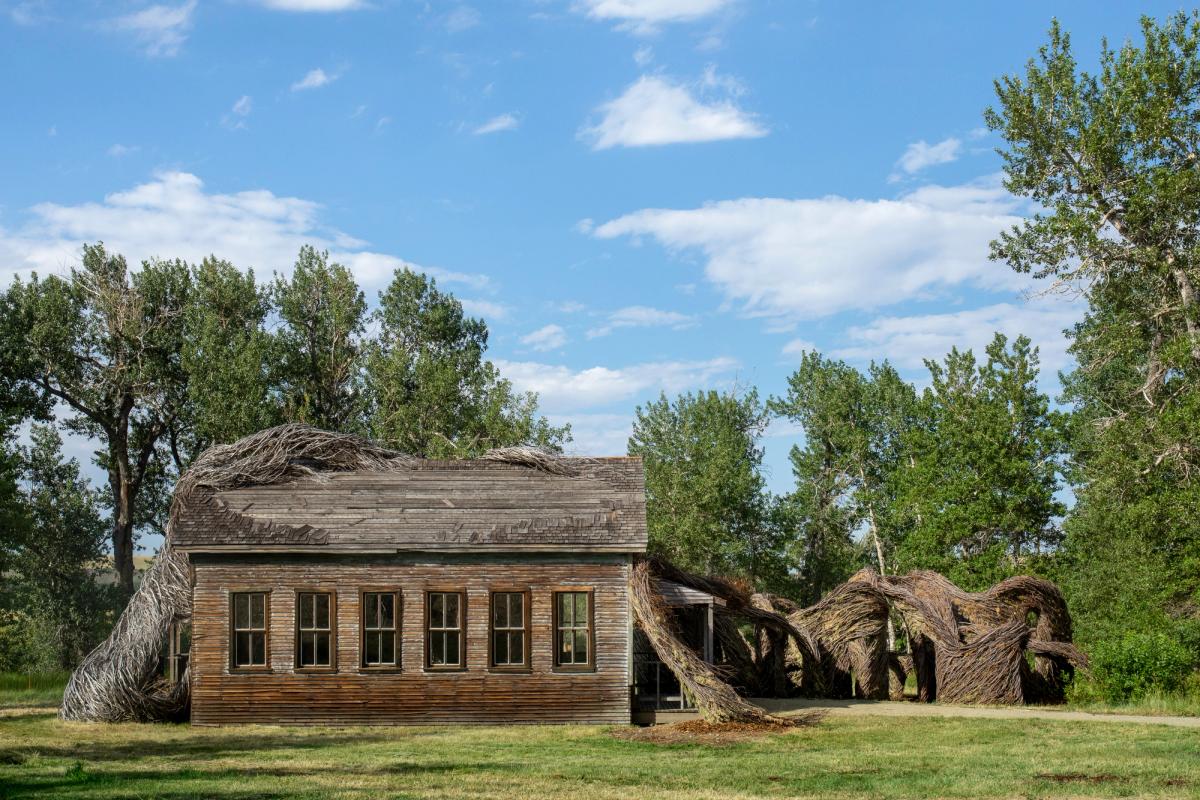The Tippet Rise Art Center, a panoramic 12,500-acre outdoor sculpture and classical music centre in southcentral Montana, relaunches its seasonal programming this weekend after a two-year hiatus. Several sculptures have been added to the grounds, one of the most complex being a complement of the “stickwork” Daydreams (2015) by the American sculptor Patrick Dougherty. The site-specific sculpture, which engulfs a replica of a local frontier-era school, was first unveiled when the centre opened in 2016 and naturally weathered throughout the seasons. The artist has adjoined the installation with a new outdoor work titled Cursive Takes a Holiday (2022)—a nod to the piece’s original composition, which pours out from the architecture onto the exterior landscape.
The work comprises hundreds of pounds of locally-sourced willow branches that are intertwined to create an undulating immersive environment framed by the sky and the Beartooth Mountains. Dougherty and a team of assistants and volunteers worked on the piece for three weeks—a strict deadline that the artist imposes on his laborious projects, which have been installed in institutions nationwide like the DeCordova Museum and Sculpture Park in Massachusetts and the Smithsonian Institution’s Renwick Gallery in Washington, DC.
Dougherty’s sculpture joins three other new works at the centre, including Whale’s Cry (1981-1983) by Mark di Suvero—the third work by the artist on the campus, which was included in his 1985 retrospective at the Storm King Art Center in upstate New York, a major influence for the Tippet Rise founders Peter and Cathy Halstead; the steel sculpture Iron Tree (2013) by Ai Weiwei; and several concrete seats designed by the architecture firm Ensamble Studio.
The 2022 season at Tippet Rise opens on 26 August (until 25 September) with a performance by the violinist Jennifer Frautschi, the cellist Arlen Hlusko and the pianist Zoltán Fejérvári in the Olivier Music Barn, a stone’s throw from Dougherty’s latest work. Over the summer, while most of the new sculptures at the centre were nearing completion, the artist spoke to The Art Newspaper about his piece and his decades-long practice that, like music composition, combines rigorous technique with whimsical thinking.

Installation view of Patrick Dougherty’s Cursive Takes a Holiday (2022) at the Tippet Rise Art Center. Courtesy of Tippet Rise Art Center/James Florio. Photo: James Florio.
The Art Newspaper: You worked with clay early in your career, before you pivoted to working with tree saplings. What inspired your shift in medium?
Patrick Dougherty: I felt constricted by the lengthy process of working with clay. I wanted to create large-scale work and found that saplings have the same malleability as clay. You can mark it easily and don’t have to wait for the piece to be fired. I started experimenting with saplings without a clear grip on the history of the medium, or how important it was in terms of more ancient traditions. I collected sticks and started to work out my ideas, which weren’t about the environment or tradition yet at that point. But I was constantly roaming and looking for ideas. Everything from Indigenous basket-making to bird nests tap into the use of this material.
The pieces have an ecological aspect, or a focus on impermanence and transience. You’ve mentioned that your works are intended to biodegrade on their own, and Daydreams is one of the first works to have a second life.
The context of your work changes constantly throughout your career. At first, the sticks were considered “found objects”, and now they are considered “environmental art”. For me, it was originally about the struggle of conquering a new material, one that is easily available and that is a product of urbanisation. But Daydreams was an unique project in that it presented the challenge of creating something more permanent, which sparked the idea that we needed some vernacular architecture in place that would allow the work to live inside and outside. The schoolhouse was the perfect foil.
As the idea for Daydreams developed, I started talking to Peter Halstead about his own schooling and how he always wished that he was outside rather than inside. That led to a storyline—some sacrilegious turning inside the schoolhouse. When it came time to revisit the work, we thought we should create something new. From my point of view, we had been in school and it was time to be out of school, to expand the outdoor portion of the work so that it would blast through the door at full force. It’s a tangential thread to the building but one that doesn’t outweigh it.

Patrick Dougherty and a volunteer working on Cursive Takes a Holiday (2022). Courtesy of Tippet Rise Art Center. Photo: Greys River Photography.
You collaborate with artists and volunteers to create your pieces, and mentioned that the process primarily requires adaptability from everyone on the crew.
Most of the time the work is unknown until we see what the material is like and who is going to help us. I was working on my own for the first few years, but then one day someone suggested that a crew could help me gather the material, which I thought was a good idea. Later, the crew wasn’t satisfied with just gathering and wanted to help on the build. I wasn’t sure about it but gave it a chance and it worked out really well.
Over time, I’ve learned to work with volunteers and not sully or lessen the idea of the work because other people are involved in it. There’s good and bad. Working with volunteers does help endear the work to the community and there’s an advertising aspect to it, but if someone has an agenda of using people from the community then it can get out of hand because that becomes the focus, not the sculpture. But it’s interesting to see people’s visions; there’s a lot of latent sculptors out there.

Installation view of Patrick Dougherty’s Cursive Takes a Holiday (2022) at the Tippet Rise Art Center. Courtesy of Tippet Rise Art Center/James Florio. Photo: James Florio.
How do you know when a piece is finished?
We have a three-week timeline and it’s nice to be controlled by timelines because the downfall of many artists is that they simply can never finish work, and the downfall of many organisations is that they stall constantly. Everyone has a reason for why things can’t happen on time. So we have a deadline, and eventually the work grows to a point where you don’t want to ruin it and get the sense that you’re not making much progress. We’re building illusions, so too much can dim the vision rather than elucidate it.
In other words, once you have a canvas, then you draw on it. Once the piece structurally stands up, we then beautify and aestheticise it. Then the final phase is to come and do the cosmetics. We erase by blending small sticks over what we don’t like. We want to take all the inconsistencies out of the surface to allow the viewer’s eye to travel along the line without coming to any abrupt stops. You have to be very careful to help with the work’s transition from the ground to the sky because those transitions are crucial to someone believing your illusion.

Patrick Dougherty working on Cursive Takes a Holiday (2022). Courtesy of Tippet Rise Art Center. Photo: Greys River Photography.
Have you ever made work that was intended to be permanent?
Not really. I’ve been dedicated to temporary work because I think it directs the viewer to a more essential concept of enjoying art in the moment. That doesn’t mean that all artists should think this way but temporality has value. Another tenet is accessibility—one that I took to the extreme by using volunteers and collaborating with organisations. I’ve never had to close any doors; people can walk up and talk to me during installation and there’s always an informative conversation that happens. People elaborate their feelings and you’re somehow able to use the energy from that. When you start thinking about what to do next, you’re always affected by your interactions with these hordes of people.
What do you hope people take away from your work?
I’ve made about 330 works, doing about 10 works every year consistently since around 1985 with some gaps in between. I pretty quickly got some acclaim and won a lot of awards, which was not that easy when you live in North Carolina and the centre of the art world is somewhere else. But people like and are drawn to my work. Over the long haul, there’s been a huge continuum. People come to me and say they have pieces of my work that are maybe decades old. It’s been entrancing for me to see the impact that the pieces have on people.
It’s very vague—you’re not getting money for it but you’re getting a kind of pleasure from seeing the profound effect the work has on people. It’s somehow playfully profound, that they found meaning in the illusionary things that I have casted.
- Tippet Rise Art Center, Fishtail, Montana; all artwork on long-term view, concert season 26 August-25 September 2022


